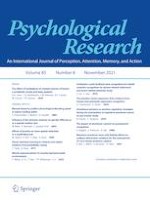23-11-2020 | Original Article
Attentional patterns as emotion regulation strategies during the anticipation of repetitive emotional scenes: an eye-tracker study
Gepubliceerd in: Psychological Research | Uitgave 8/2021
Log in om toegang te krijgenAbstract
As difficulties in managing the anticipation of situations is one of the characteristics of emotional problems, the study of regulatory strategies during anticipatory period anticipation is important. In the present study, attentional patterns during the anticipation period were studied. The ability of those attentional patterns to regulate mood after the event’s occurrence was analyzed. An experimental paradigm was designed in which participants repeatedly anticipated emotional information. Attentional patterns in response to emotionally expressive faces (happy and sad) were recorded with an eye tracker. The results showed that the valence of the expected outcomes did affect attentional preferences. Specifically, participants spent more time looking at sad faces when they anticipated a negative rather than a positive outcome. The opposite pattern was found for happy faces. With respect to the ability to regulate the emotions of these attention patterns, it was found that emotions experienced after a negatively anticipated event were independent of previous attention patterns, while happiness experienced after a previously anticipated positive event was found to be related to attentional patterns. Specifically, people who spent more time looking at happy faces during the anticipation of a positive outcome reported higher levels of happiness after the event. In conclusion, these results indicate that during the anticipation of emotional outcomes participants implement attentional strategies, although the emotions associated with experiencing those outcomes were independent of those attentional patterns in the negative anticipation, they were found to magnify positive emotions in positive anticipation.
